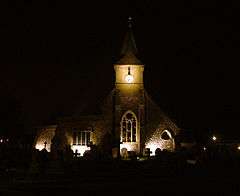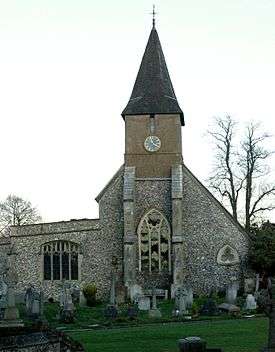Sanderstead
| Sanderstead | |
 All Saints' Church, floodlit. |
|
 Sanderstead |
|
| Population | 12,777 (2011 Ward)[1] |
|---|---|
| OS grid reference | TQ337613 |
| London borough | Croydon |
| Ceremonial county | Greater London |
| Region | London |
| Country | England |
| Sovereign state | United Kingdom |
| Post town | SOUTH CROYDON |
| Postcode district | CR2 |
| Dialling code | 020 |
| Police | Metropolitan |
| Fire | London |
| Ambulance | London |
| EU Parliament | London |
| UK Parliament | Croydon South |
| London Assembly | Croydon and Sutton |
Coordinates: 51°20′09″N 0°04′54″W / 51.3358°N 0.0818°W
Sanderstead /ˈsɑːndərstɛd/ is a village in the London Borough of Croydon, situated on high ground at the edge of the built-up area of Greater London. From 1915 to 1965 it formed a parish in the Coulsdon and Purley Urban District of Surrey.[2] Having been a farming community in previous centuries, Sanderstead is now essentially a dormitory village for commuters to central London and Croydon. The Grade I listed[3] All Saints' Church dates from the 13th century but was extensively altered in later periods. Sanderstead station is lower down the hill and has trains to East Croydon and central London, and to East Grinstead and Uckfield. Sanderstead was the place of origin of the Sanders surname.[4]
History

There is evidence of prehistoric human activity in and around Sanderstead. In 1958–60 the Sanderstead Archaeological Group excavated in the vicinity of Sanderstead pond and revealed the presence of man as far back as the Mesolithic Period nearly 12,000 years ago, as well as pottery fragments dated between 100 AD and 1300 AD and a bronze belt from the end of the Saxon era.[5] North of the village at Croham Hurst, upon a wooded hill, are circular barrows believed to be from a Bronze Age settlement. This is now part of a public open space and the site is marked by a brass monument. A Romano-British homestead (small farming settlement) was discovered during the construction of the Atwood School. During the 1980s, when the school was extended, further excavation revealed the remains of several round huts, hearths, a brooch, and pottery, some of which hailed from North Africa.
An Anglo-Saxon reference to Sanderstead can be found in the will, dated 871, of Alfred, an ealdorman. The village lay within the Anglo-Saxon administrative division of Wallington hundred. It later appears to have been given to St Peter's Abbey, Winchester (Hyde Abbey) by Æthelflæd, the wife of Edgar the Peaceful and mother of Edward the Martyr, where it remained after the Norman Conquest.[6]
Sanderstead appears in the Domesday Book of 1086 as Sandestede, and belonging to St Peter's Abbey, Winchester. It had a total household population of 26 including 21 villagers, 4 slaves and 1 cottager.[7] Its Domesday assets were assessed as 5 hides, and 10 carucates of arable land. It had 9 ploughs and wood worth 30 hogs.[8] Its Domesday entry records that in the time of Edward the Confessor it was valued at 100 shillings, and now 12 pounds; and yet it produces 15 pounds.[9]
The village was granted to Sir John Gresham by Henry VIII following the Dissolution of the Monasteries. It was passed to his son Richard who subsequently sold it to John Ownsted, the transfer being ratified in 1591. Ownsted died without issue in 1600, and devised his estates to his two sisters and cousin Harman Atwood, with Atwood subsequently purchasing the shares of his joint legatees. The Atwood family had a long association with Sanderstead, with inscriptions at the local church indicating a presence in the village from the reign of Edward II.[10]
On Monday, 6 September 1731, the nearby Sanderstead Common was the venue for an important cricket match between Surrey and Thomas Chambers' XI, Surrey winning the match by an unknown margin.[11] On Monday, 26 June 1732, Surrey played London on the common. This match was drawn.[12]
The manor house, known as Sanderstead Court, was substantially remodelled by Harman Atwood. This large country house was probably first constructed in the early sixteenth century. The Atwoods continued to occupy the house until 1778, when it was devised to Atwood Wigsell. It was turned into a hotel in 1928, and before the Second World War it was used by the Royal Air Force (RAF). It was very badly damaged by fire (not a bomb) in 1944 and was demolished in 1958. One very small part of the hotel building does however still stand. On the site now stands "Sanderstead Court", a three-storey block of flats.
One of the more curious aspects of Sanderstead is that it has no pub, unlike nearby Warlingham which has around six. The reason for this is that some time ago, both the Atwood family (the Lords of the Manor) and the Rector of the church were against drinking. At the British Library there is a letter from the rector writing to both the parishes of Sanderstead and Warlingham (which lies to the south of the village) calling the latter "sinners" as they visited the pubs.
On the edge of the village lies the site of the Old Saw Mill now home to a number of private residences and the picturesque setting for Sanderstead Cricket Club. Cricket has been played here since 1883 and continues to the present day with four teams playing in the Surrey Championship and a number of other Colts and friendly teams.[13]
Located between Limpsfield Road and Kingswood Lane is the large Kings Wood. It derives its name from a small wood to the north of Kings Wood Lodge. In 1823, Ordnance Survey Maps called the wood Sanderstead Wood, but this might be due to a mistake. It covers some 147½ acres, criss-crossed by ancient rides and is on relatively flat ground. It was purchased in 1937 under the Green Belt Act by the local council and is now public open space. There is the site of a Romano-British settlement on the northern boundary, a small farmstead undisturbed for 2000 years.[14]
Education
Sanderstead has four schools, namely; Atwood Primary School, Gresham Primary School, Kingsdown Secondary School and Ridgeway Primary School. It is also conveniently placed for a number of others located within a couple of miles from the village including Croydon High School, Harris Academy Purley, Riddlesdown Collegiate, Royal Russell School, The Quest Academy, Thomas More Catholic School, Warlingham School, and Whitgift School.
Demography
The 2011 census showed that White British was the largest ethnic group in Sanderstead ward, forming 76% of the population.[15]
Politics
Sanderstead has consistently returned Conservative Party MPs to the local seat of Croydon South and has also returned Conservative members to the local council. Since the north of Croydon tends to return Labour councillors, the two halves of the borough are often at loggerheads. The current MP for Croydon South is Chris Philip.
Sanderstead is one of the twenty-four wards constituting Croydon London Borough Council. Three councillors are elected every four years to represent the ward on the Council. The current elected Councillors are:
| Elected | Member | Ward | |
|---|---|---|---|
| 1998 | Lynne Hale | Sanderstead | |
| 2002 | Timothy Pollard | Sanderstead | |
| 2006 | Yvette Hopley | Sanderstead | |
Notable residents
- John Atwood (1576–1644) was the Assistant Governor of the Plymouth Colony, in the US state of Massachusetts, in 1638. His childhood was spent at Sanderstead Court.
- Margaret Bondfield (1873-1953), the first woman to sit in Cabinet in the United Kingdom (1929-1931), died in Sanderstead on 16 June 1953.[16]
- Ruth Ellis (9 October 1926 — 13 July 1955), the last female to be executed in the United Kingdom, lived in a house on Sanderstead Hill.
- I, Ludicrous, lead singer David Rippingale, aka William Hung, spent his formative years in Sanderstead (1958-1971)
- Charlie Kray, criminal, elder brother of gangsters Ronald and Reggie Kray. Lived on the Limpsfield Road.[17]
- Stephen Rumbold Lushington (1775–1868) lived for a time at Sanderstead Court and his daughter was born there in 1816. He was Joint Secretary of the Treasury (1824-7), Governor of Madras (1827–32), and M.P. for Rye (1807–12) & for Canterbury (1812–1830)
- Kate Moss, an English model, originally lived near Sanderstead. She lived in Addiscombe and then moved to Sanderstead as a teenager. She went to Ridgeway Primary School on Southcote Road in Sanderstead and then to Riddlesdown High School on Dunmail Drive.
- Malcolm Muggeridge was born in Broomhall Road on 24 March 1903.[18]
Nearest places
Nearest railway stations
References
- ↑ "Croydon Ward population 2011". Neighbourhood Statistics. Office for National Statistics. Retrieved 10 October 2016.
- ↑ Vision of Britain - Sanderstead (historic map)
- ↑ http://www.britishlistedbuildings.co.uk/en-201146-church-of-all-saints-croydon
- ↑ Generations, a Thousand Year Family History by Ralph Sanders; ISBN 1425795722
- ↑ http://www.croydon.gov.uk/leisure/parksandopenspaces/parksatoz/sandersteadpond/ssphistory
- ↑ A topographical history of Surrey, by E.W. Brayley assisted by J. Britton ... By Edward Wedlake Brayley, John Britton, page 40
- ↑ http://domesdaymap.co.uk/place/TQ3461/sanderstead/
- ↑ Surrey Domesday Book
- ↑ A topographical history of Surrey, by E.W. Brayley assisted by J. Britton ... By Edward Wedlake Brayley, John Britton, Page 40
- ↑ A topographical history of Surrey, by E.W. Brayley assisted by J. Britton ... By Edward Wedlake Brayley, John Britton, Page 41
- ↑ Buckley, p. 6.
- ↑ Buckley, p. 7.
- ↑ http://sanderstead.play-cricket.com/website/web_pages/80378
- ↑ http://www.croydononline.org/history/places/parks_and_open_spaces/kingswood.asp
- ↑ http://www.ukcensusdata.com/sanderstead-e05000160
- ↑ "Margaret Bondfield", Britannica
- ↑ http://www.independent.co.uk/news/kray-on-drugs-charges-1307719.html
- ↑ My Life in Pictures ISBN 0-906969-60-3
Bibliography
- Buckley, G. B. (1935). Fresh Light on 18th Century Cricket. Cotterell.
- Maun, Ian (2009). From Commons to Lord's, Volume One: 1700 to 1750. Roger Heavens. ISBN 978 1 900592 52 9.
External links
- Local guide covering Sanderstead
- Sanderstead Village Community
- History of Sanderstead Village
- Sanderstead Parish (Church of England)
- Sanderstead Evangelical Church
- A gallery of images of Sanderstead
- Leach, John (2008). "Classification of cricket matches from 1697 to 1825". Stumpsite. Archived from the original on 29 June 2011. Retrieved 11 March 2015.
